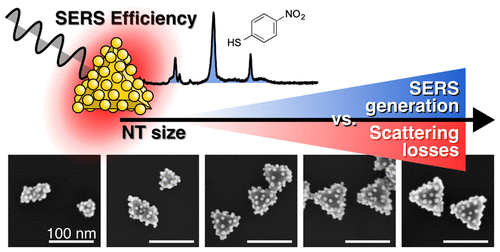News blog
December 9-10th 2021
Graduation Event of "Leading for Tomorrow" Program
Although the graduation event of the “Leading for Tomorrow” program had to be held as an online event rather than in Berlin, it turned out to be a great success. Personally, the personalised workshops on “Personal Brand & Storytelling“, “Change Management“, and “Remote Leadership” helped me the most, especially in the view of these challenging times.
I congratulate all the participants and express my deepest gratitude to all the lecturers from OSB Berlin:
I am also very grateful to the invited guests from industry and academia who gave an insight into their working environment and leadership experience. All in all, it was a very successful series of events. Many thanks to the German Physical Society (DPG) for the organization and to the Wilhelm und Else Heraeus Stiftung for the financial support.
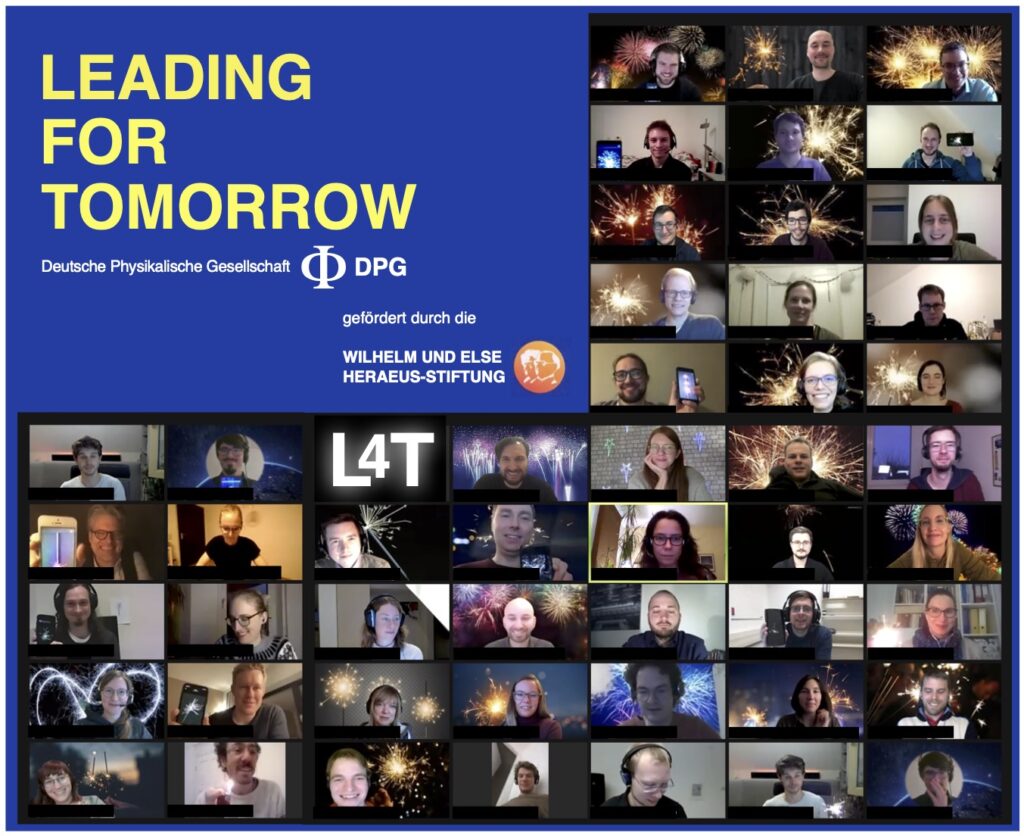
November 2nd 2021
New article on libraries of Au nanostars just published
Our work on nanoparticle libraries optimised SERS and combinatorial screening of synthesis parameters is now available at Chemistry of Materials. Have a look!
“Love this paper!”
@SaraSkrabalak
Editor-in-Chief, Chemistry of Materials
I was so happy to see the lovely tweet from Sara! Best regards to Bloomington, Indiana.


October 28-29th 2021
EPS Event: Grand Challenges in the Horizon 2050
Over the last decades, the EPS community has been promoting the role of physics in addressing some of the biggest problems humankind faces right now.
What about the big challenges in physics on a longer term? At the horizon 2050, what might be on the world’s physics agenda to solve? Predictions are difficult but we can get clues from how current trends in science and technology may play out, where physics has a key role to play. International collaboration and interdisciplinary science will play a crucial role to address these grand challenges.
This is the target of the GRAND CHALLENGES IN THE HORIZON 2050 meeting, exploring our ability to imagine and shape the future by making use of the scientific method.
I look forward to participating in this EPS event, even if only via online, and hearing the opinions and visions on the challenges ahead.

October 28th 2021
Paper on mechano-optical materials published
Our work on mechano-optical materials has finally appeared in the October issue of Small Methods. Therein, we demonstrate nanostructures with reversibly tunable lattice-plasmon resonances consisting of self-assembled superlattices on stretchable substrates. Macroscopic mechanical strain allows a single lattice structure to be adapted to both red-shifted and blue-shifted excitation lines for maximum surface-enhanced Raman scattering. This post-assembly fine-tuning of optical parameters enables rapid screening for most-efficient superlattice designs.
Have a look at the paper and the cover page!
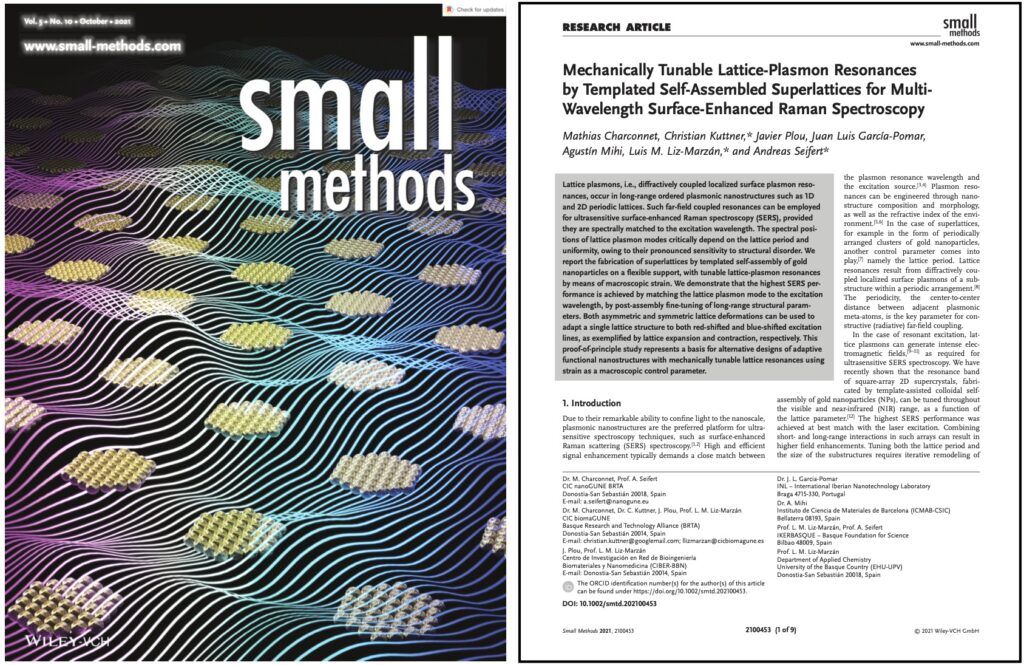
October 18th 2021
Manuscript accepted in Chemistry of Materials
Our paper entitled “Plasmonic Gradient Arrays for Rapid Screening of Surface-Enhanced Raman Scattering Efficiency: Particle Libraries of Gold Nanostars” has been accepted for publication in Chemistry of Materials. This work describes the concept of forming an array of gold nanostars with a continuous gradient in size and shape using the technique of interrupted growth.
I am particularly happy for Valentina Piotto, who worked in the NANOBIOME project under my supervision during her visit to the lab of Prof. Luis M. Liz-Marzán. Congratulations, Valentina! Working with you was a great pleasure.
Unfortunately, since production will take a few more days, the paper is not yet available online, but will be soon.

September 27-28th 2021
Leading in Practice Workshop at Berlin
Once again, the journey to the two-day workshop “Leading in Practice“, this time at the Magnus Haus in Berlin, was accompanied by torrential rain, flooding and traffic chaos. Due to lightning damage to signal boxes, defective trains and delays of several hours, it was an extraordinary challenge to travel from Bayreuth to Berlin. Nevertheless, it was a great pleasure for me to participate in the second L4T workshop of the Leading for Tomorrow program of the German Physical Society (DPG).
My personal highlight was the OPQ32 personality test, which provides intimate feedback on interpersonal behavior, thinking style, and emotional and motivational drives.

September 16th 2021
Paper selected as inside front cover
Our design proposal was selected as the inside cover for the October issue of Small Methods. The image artistically illustrates the interaction of light with a superlattice landscape of gold nanoparticles arranged in periodic clusters. The superposition of plasmonic and photonic modes is depicted as multicoloured waves resembling a churned-up water surface that washes around the clusters like rocks.
In our recent article “Mechanically Tunable Lattice-Plasmon Resonances by Templated Self-Assembled Superlattices for Multi-Wavelength Surface-Enhanced Raman Spectroscopy“, we demonstrate mechano-optical nanostructures with reversibly tunable lattice-plasmon resonances. Macroscopic mechanical strain allows a single lattice structure to be adapted to both red-shifted and blue-shifted excitation lines for maximum surface-enhanced Raman scattering (SERS). This post-assembly fine-tuning of optical parameters enables rapid screening for most-efficient superlattice designs.
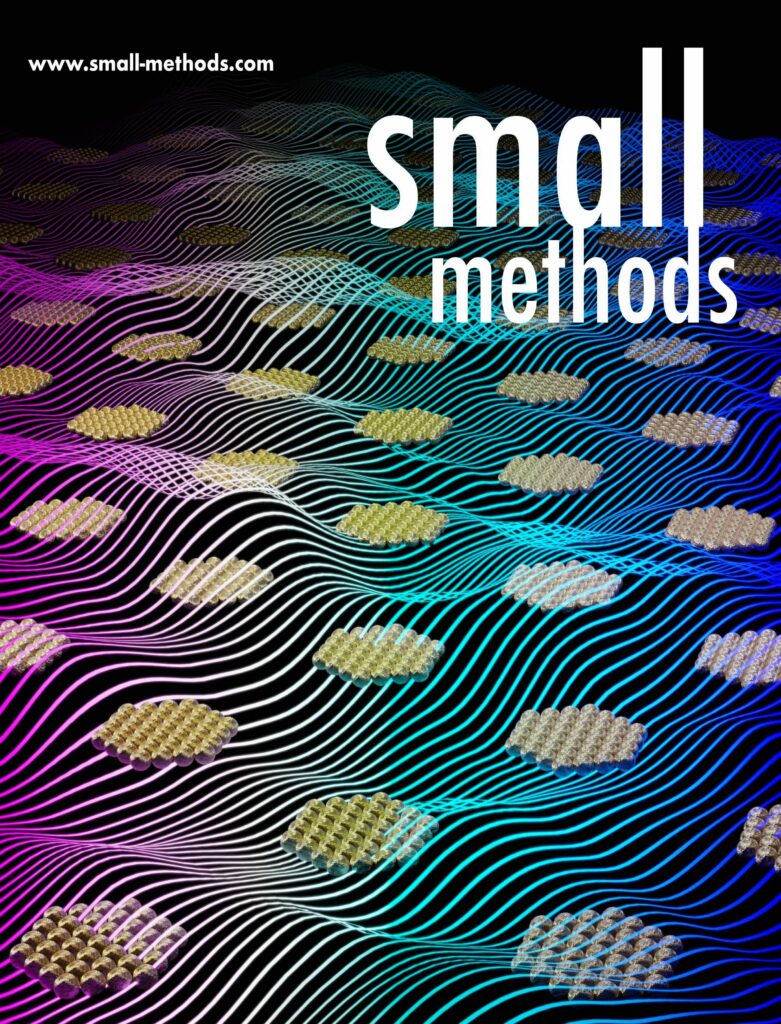
July 15th 2021
Leading in Practice Workshop at Bad Honnef
After torrential rain, flooding and traffic chaos, I had the pleasure of attending the two-day workshop “Leading in Practice” at the Physikzentrum Bad Honnef. This event is the second event within the Leading for Tomorrow programme of the German Physical Society (DPG).
Two in-depth workshop sessions were held on the topics of leading and developing co-workers, strategy and innovation, as well as project management. One of the highlights of the event was the discussion round with invited guests from science and industry on a wide range of topics related to leadership and good management practices.

July 8th 2021
Paper selected for "Hot Topics: Surface and Interfaces"
Mathias’ recent article titled “Mechanically Tunable Lattice-Plasmon Resonances by Templated Self-Assembled Superlattices for Multi-Wavelength Surface-Enhanced Raman Spectroscopy” was selected for Wiley-VCH’s Hot Topics in Chemistry and Materials: Surfaces and Interfaces. This collection contains the hottest research in chemistry and materials science and embodies a virtual special issue on surfaces and interfaces (DOI: 10.1002/(ISSN)2196-7350.hottopic-interfaces), which has been running since July 2018. Congratulations!
“Surfaces and interfaces are where the action happens. Catalysis, molecular recognition, charge transfer, polymerization and many other critical processes take place at the boundary between one medium and another. With the need to integrate new materials into devices, and applications ranging from catalysis to sensors, medicine to self-cleaning surfaces, and displays to lasers, fundamental and applied studies of surface and interface processes and optimization are of critical importance in developing new technology to meet today’s challenges.”
Take a look at the other exciting collections of Hot Topics in Chemistry and Materials.

June 23rd 2021
"Leading for Tomorrow" virtual kick-off meeting
As one of the lucky few, I was selected to be a member in the “Leading for Tomorrow” training program of the German Physical Society (DPG).
This multi-part program started with a virtual kick-off event, covering various aspects of leadership. After this introduction, the program will continue with multi-day face-to-face meetings later in the year in Bad Honnef and Berlin.
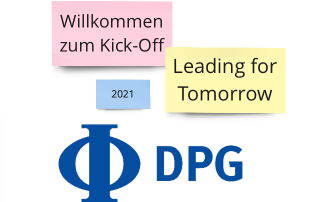
June 21st 2021
Manuscript accepted in Small Methods
Our contribution entitled “Mechanically Tunable Lattice-Plasmon Resonances by Templated Self-Assembled Superlattices for Multi-Wavelength Surface-Enhanced Raman Spectroscopy” has been accepted for publication in Small Methods. This work describes the concept of controlling and reversibly adjusting the coupling of plasmonic and photonic modes in periodic assemblies by means of substrate deformation.
Unfortunately, since production will take a few more days, the paper is not yet available online, but will be soon (DOI: 10.1002/smtd.202100453).

June 7th 2021
Congratulations Dr. Charconnet!
A reason to celebrate! Mathias Charconnet successfully defended his PhD thesis on “Self-Assembly and Optical Properties of Gold Nanoparticle Superlattices for Surface-Enhanced Raman Spectroscopy” (PDF) today. I am delighted that he was able to counter the demanding questions of the examiners well. Mathias conducted his work in a collaboration between the groups of Prof. Andreas Seifert (Nanoengineering, CIC nanoGUNE) and Prof. Luis M. Liz-Marzán (BioNanoPlasmonics, CIC biomaGUNE). It was an honor and a great pleasure to co-mentor him and I would like to thank Andreas for his trust. It was an exciting collaboration.
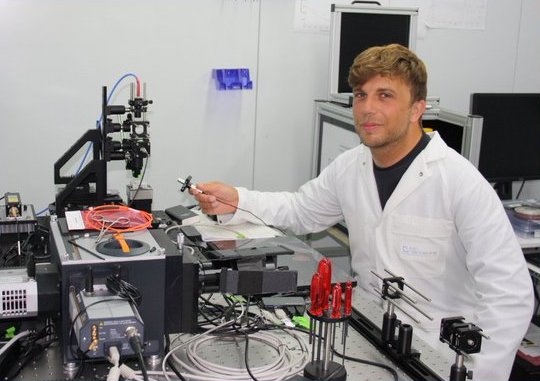
June 6th 2021
New milestone reached
According to Google Scholar, the number of citations has reached 1500. It’s nice to take a look at the numbers from time to time; although it’s clear that they can basically only go up.
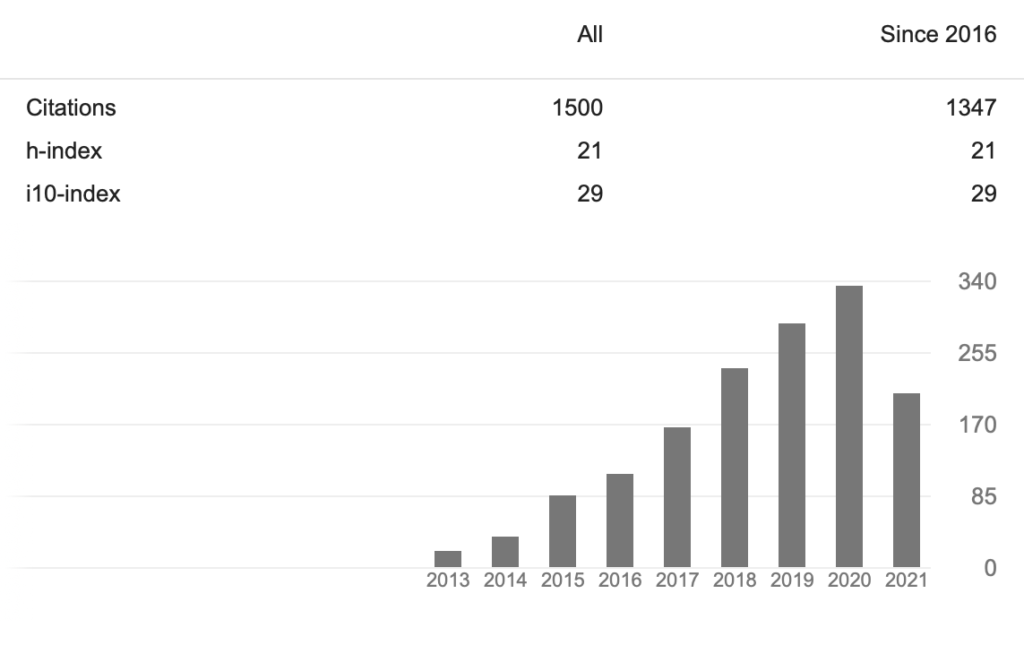
May 11th 2021
Discussion minutes available now
The themed collection of the Faraday Discussion: Time-Resolved Imaging of Photo-Induced Dynamics has been released. In addition to the contributed papers, the discussion minutes provide an excellent overview of the lively communication at this online event:

February 4th 2021
Virtual Faraday Discussion
The virtual Faraday Discussion on Time-Resolved Imaging of Photoinduced Dynamics just ended. I can honestly say that I learned a lot. It was obvious that the fast spectroscopy community speaks a different language and for me as an outsider it was a challenge to get in at first. But if you are interested in a new subject, you should not shy away from learning something new.
Our poster was well received and the engaging conversations were exciting. Overall, I enjoyed the cross-disciplinary communication and I am convinced that the discussions were a success.
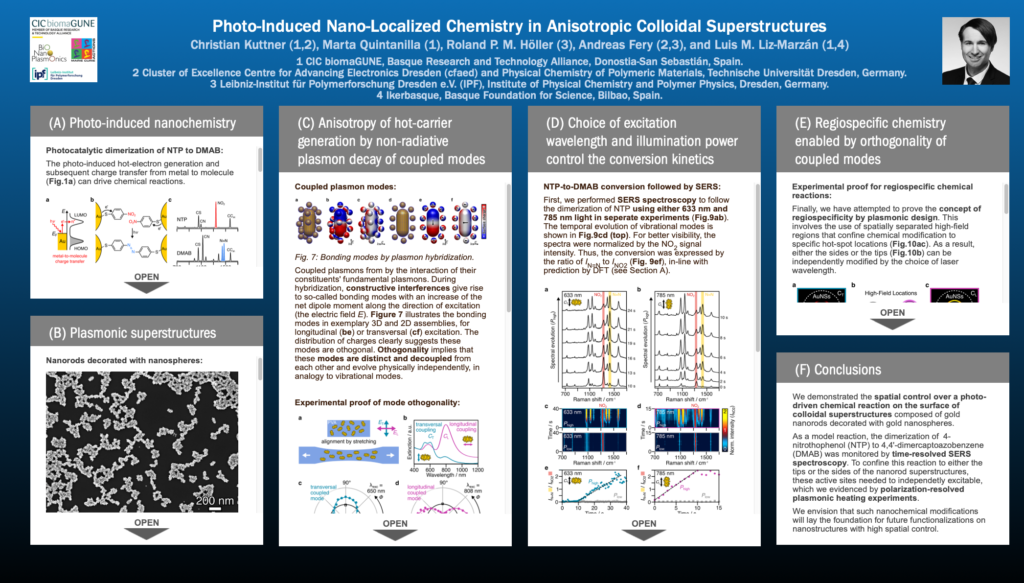
January 18th 2021
Mumbai's Faraday Discussion goes virtual
On February 1-4, the Faraday Discussion on Time-Resolved Imaging of Photoinduced Dynamics will be held as a virtual meeting. This meeting was scheduled in Mumbai, but had to be rescheduled due to the ongoing pandemic. I am very excited to take part and to present a virtual poster.
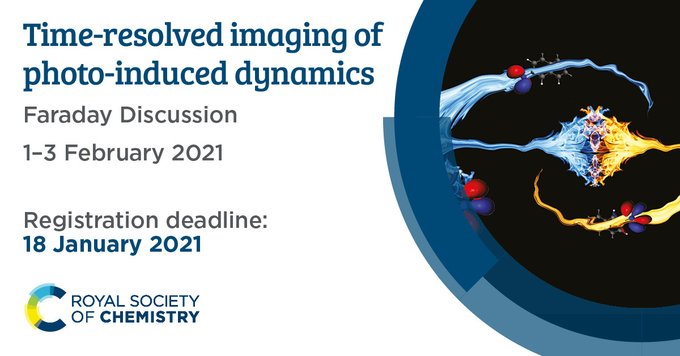
December 21st 2020
Paper accepted in ACS Catalysis
Congratulations to Heloise on this new publication in ACS Catalysis on the mechanistic workings of light-driven catalysis of enzymes adsorbed on plasmonic nanomaterials (DOI: 10.1021/acscatal.0c04919, PDF) .
Heloise and I met during her stay at CIC biomaGUNE and it was a pleasure to do research with her. Together we performed photo-thermal experiments to correlate the catalytic activity with the generation of heat under NIR irradiation. We could show that the plasmonic heating accelerated the last step of the reaction by favoring product release. If this caught your interest, then also have a look at her recent review article in Biochemistry.
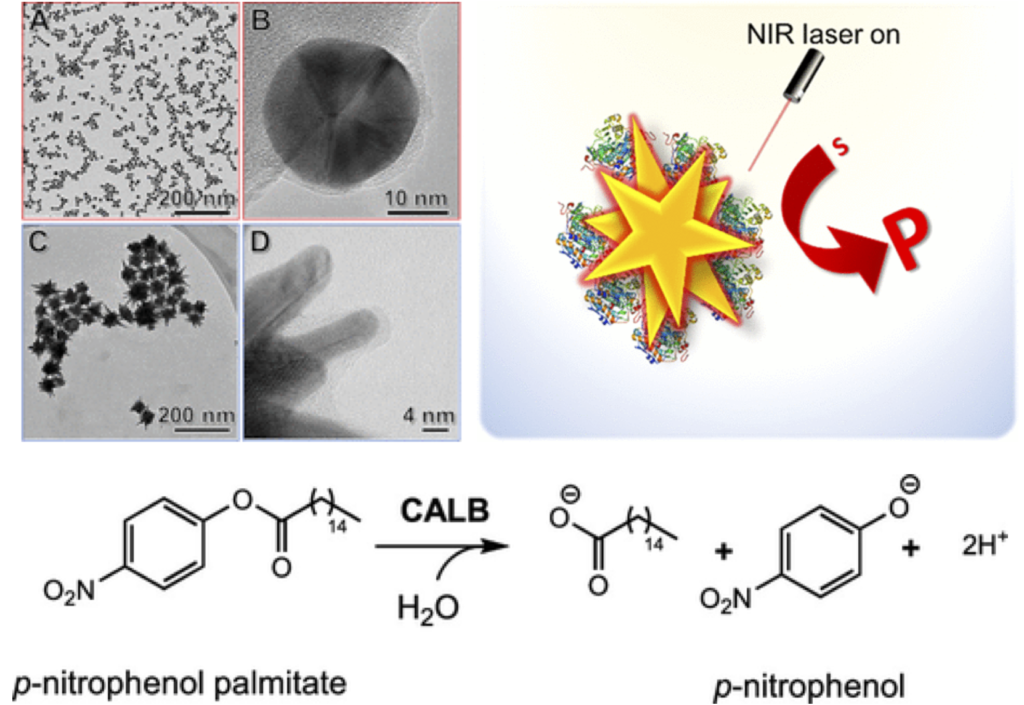
December 11th 2020
Paper published in ACS Applied Materials & Interfaces
Our work on the robustness of colloidal SERS sensing probes has been published in ACS AMI (DOI: 10.1021/acsami.0c16398, PDF). Congratulations to Roland for his 2nd paper on plasmonic supraparticles linked by protein. This research was conducted in a cooperation between the Leibniz Institute of Polymer Research (IPF Dresden) and the Leibniz Institute of Photonics Technology (IPHT Jena). Best thanks to Izabella Jahn, Dana Cialla-May, and Prof. Jürgen Popp for the excellent cooperation.
Our paper deals with optically isotropic core/satellite superstructures with spherical cores, which exhibit lower SERS activity compared to anisotropic assemblies, but serve as a simple and reliable model system. We employed this model to highlight the aspect of sensing robustness which is of high importance for analytical applications.
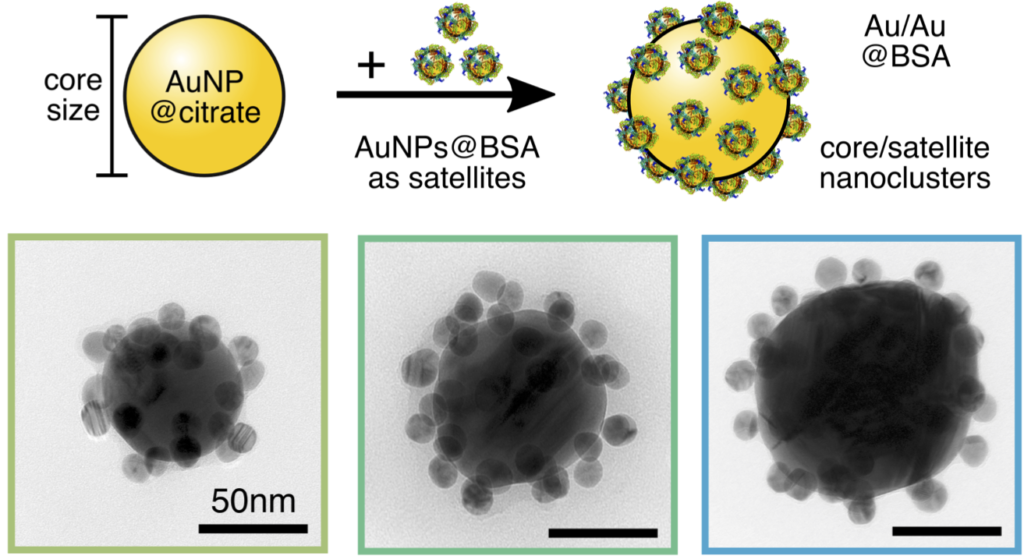
November 12th 2020
Discussion minutes now available
The themed collection of the Faraday Discussion: Biological and Bio-Inspired Optics (Living Light Edition) is out now. Have a look at the contributed articles and the general discussions:
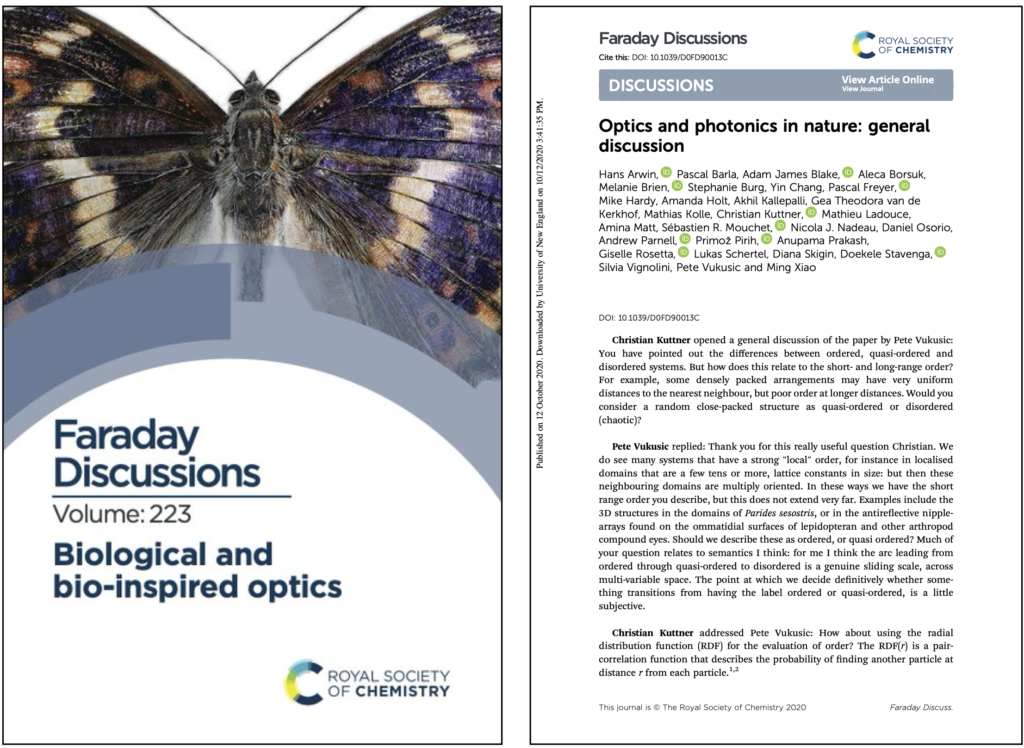
July 20th 2020
Virtual Faraday Discussion on bio-optics
The new virtual addition to the Faraday Discussions series was a full success. The biennial meeting organised by the Living Light community focus on the light-matter interactions in living organisms. I had the pleasure to see many fascinating talks on biological and bio-inspired optics. In particular, the talks by Ullrich Steiner about designing refractive index fluids using the Kramers-Kronig relations.
Although plasmonic materials are somewhat exotic here, it was an excellent way to reach a new community of people. Our poster on the Size-Controlled Light-Matter Interactions of Colloidal Superstructures generated a lot of interest and I really enjoyed the discussions during the sessions. I was also delighted to meet a couple of friends from FAU Erlangen.

July 2nd 2020
New cover page
Hurray! Our proposal for the Journal Cover was selected for the July issue of ACS Photonics.
The image artistically illustrates the interaction of light with a colloidal superstructure of a triangulated core decorated with gold nanoparticles. Besides the excitation of hotspots at the so-called satellite particles, the pronounced diffuse scattering is portrayed, which is characteristic for larger core particles above 100 nm in size.
Have a look at the full article (DOI: 10.1021/acsphotonics.0c00642, PDF)!
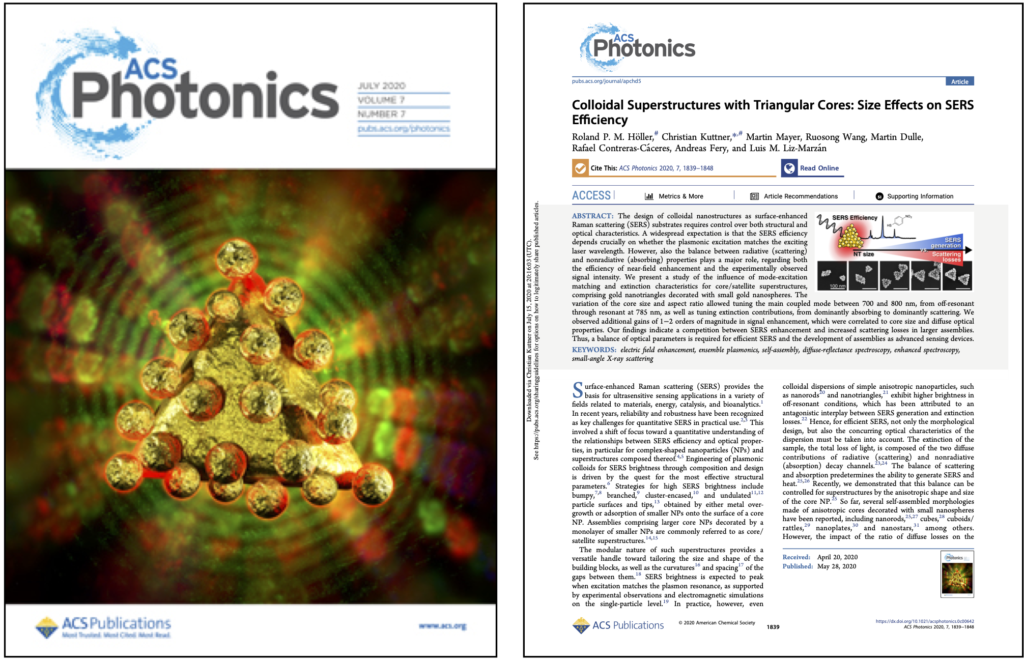
May 28th 2020
Paper published in ACS Photonics
Roland’s work on colloidal superstructures with triangular cores has been published in ACS Photonics (DOI: 10.1021/acsphotonics.0c00642, PDF). On the example of these core/satellite assemblies, comprising gold nanotriangles decorated with small gold nanospheres, we show the influence of mode-excitation matching and extinction characteristics on the SERS efficiency.
The variation of the core size and aspect ratio allowed tuning the main coupled mode between 700 and 800 nm, from off-resonant through resonant at 785 nm, as well as tuning extinction contributions, from dominantly absorbing to dominantly scattering. Our findings indicate a competition between SERS enhancement and increased scattering losses in larger assemblies. Thus, a balance of optical parameters is required for efficient SERS.
